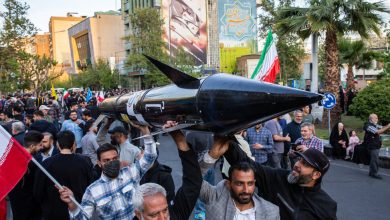Videos Show an Ordinary New York Morning Erupting Into Chaos on the N Train

On videos captured inside a smoke-choked subway car, commuters can be seen hunching into their collars, pulling sleeves and hoods across their faces, trying to breathe. Before the doors open, there are few panicked screams — just the familiar muffled shriek of a rush hour train on its tracks, punctuated by moans of pain.
When the familiar “ding” of the doors opening sounds at the next stop, riders burst off, gasping amid curls of smoke.
“There’s been a shooting!” a woman says as she flees. Behind her a man limps out from the car.
The attack on Tuesday morning, in which a man released two smoke bombs inside a car on a northbound N train and opened fire, injured 16 people — 10 by gunfire. And in an instant, it turned the subway — New York City’s quotidian icon — into a bloody scene of horror.
Tuesday evening police named a “person of interest” in the shooting, Frank James, without releasing any details about him. They asked for help from the public in locating him.
As police searched for the gunman who perpetrated the mass shooting on a subway — a nightmarish scenario that until now the city had avoided — officials and subway riders alike began to grapple with what the attack might mean for the future of the city’s transit system, and New York itself. Their subway, once the target of mundane gripes over tardiness and trash, had become the latest symbol of a city frayed by violence.
On Tuesday afternoon, Hagar Hassan, 20, an electrical engineering student at the College of Staten Island, emerged from the subway shaken after finishing her job at a bank in midtown Manhattan.
“It was terrifying to be on the train,” she said. “I thought: Maybe he’s here.”
An increase in violent crime has plagued New York’s subway system since the beginning of the pandemic, deterring riders and prolonging a pandemic-fueled drop in overall ridership. In 2021, rates of violent crime in the subway per million weekday passengers spiked almost across the board compared with 2019, before the pandemic. Felony assaults in the system rose nearly 25 percent.
The State of New York City’s Subway
- New Subway Chief: Richard A. Davey, a former Massachusetts transportation secretary, will be the first permanent leader of New York City Transit since the pandemic began.
- Perspectives From the Platform: We visited three stations to see where subway riders have returned, and where they haven’t.
- Platform Barriers: In a reversal, the M.T.A. will test the use of platform barriers at three stations amid mounting concerns over safety.
- Homelessness Plan: Mayor Eric Adams’s plan to remove homeless people who shelter in the subway appeared to be off to a slow start.
- Transit Crime: A high-profile killing and the varied nature of some attacks show the challenge Mr. Adams faces.
The crime spike has continued even after Mayor Eric Adams unveiled plans in January to send hundreds of street-level patrol officers to regularly inspect subway stations and redeploy officers from desk jobs onto the trains. For January and February, felony assaults were up 10 percent over the same period last year.
But Tuesday’s chaos stood out: A man in a worker’s vest put on a gas mask, opened a canister that filled the subway car with smoke and then opened fire, the police said.
Once the train doors opened, sending smoke billowing through the station, fearful riders fled, many of them hurrying onto an R train sitting across the platform. Subway seats and cars were streaked with blood as people called for help.
Attacks on mass transit have broad impacts, “because we live in public spaces,” said Louis Klarevas, a research professor at Teachers College, Columbia University and author of the book “Rampage Nation: Securing America from Mass Shootings.
“How many millions of people, how many millions of New Yorkers, have been on that particular platform, in that particular train?” he said. “There is a heightened sense of insecurity that results from these type of attacks, because it is easy for us to relate to them, because we can see ourselves in them.”
The 36th Street stop is in an area of Sunset Park that is home to many Mexican and Latin American immigrants. The N train, which starts in Coney Island, cuts through immigrant-heavy neighborhoods representing much of the globe. On Tuesday afternoon, investigators surrounded the station, where about 9,000 people passed through the turnstiles to catch the D, N, or R lines on an average weekday in February, according to the transportation authority’s data.
In the station, as the attack unfolded, were a line cook who worked in a bodega, an electrician, high school students and many others.
Video captured by riders and people on the platform showed the familiar space of a subway car transformed into a trap. By Tuesday afternoon, with the perpetrator still at large, news of the shooting echoed through subway announcements, messages from friends and family, and news alerts.
Disruptions continued throughout the day: Several lines were shut down or running with delays, complicating people’s commutes. At the Atlantic Avenue-Barclays stop in Brooklyn, several M.T.A. workers stood by entrances to the subway, fielding anxious questions from passengers about alternative routes.
On Tuesday, Marjorie Michele, 50, a nursing technician from Ocean Hill, Brooklyn, took an Uber home from work, she said. Lines were still snarled from the attack, and it felt safer.
“It could have been me, it could have been any of my children,” Ms. Michele said. “Imagine those poor people who got shot this morning, they woke up this morning just to get wherever they were going.”
The day’s trauma would echo far beyond the train car in which the attack occurred, said Jaclyn Schildkraut, an associate professor of criminal justice at the State University of New York at Oswego, who studies mass shootings.
“In a mass shooting, there is a lot of attention focused on people who are killed or who are injured, and rightfully so,” she said. “But you had a train full of people who may not have been physically injured but who are going to bear traumatic injuries, and you have an entire city that is part of a bustling metropolis, that is now questioning their safety.”
Mayor Eric Adams had vowed to crack down on subway violence, and the shooting came amid what was already an increased police presence. A few weeks after a woman was pushed to her death in front of a train in mid-January and a homeless man was charged with her murder, Mr. Adams announced plans to stop homeless people from sheltering on trains and platforms and to have the police evict people who are not using the trains for transportation.
The shooting threatens the slow return riders had begun to make to the subway. Its fiscal health has been seen by officials as linked to the aboveground economy of Manhattan, particularly its business districts. Ensuring a safe subway system has been part of a strategy to lure people back to offices, and tourists back to the city.
Ridership had begun to tick up: For the third week of March — the most recent for which statistics are available — the subway averaged about 3.2 million riders per weekday, about 58 percent of the prepandemic average. That is a significant increase from the 1.8 million riders per weekday in the same week of 2021, but still a far cry from the prepandemic average of more than 5 million riders per weekday.
Subway ridership has been hobbled by the shift to remote work. But in a recent survey by the Metropolitan Transportation Authority, fear of crime and harassment was the top factor cited by former riders who have left the subways; 90 percent of them said it was an important factor in their decision about whether to ride the subway once again.
As the gunman remained at large, some people avoided the subway entirely. Nayah Martin, 22, who uses the 36th Street station to get to her job at a surgery center nearby, was planning on taking an Uber. “It spooked me,” Ms. Martin said. “I’m not trying to stay on the subway.”
Ana Ley, Michael Gold, and Alexandra E. Petri contributed reporting.



